|
All Materials herein ©2003 Bentley Publishers Inc.
This material cannot be reproduced without express permissions from Bentley Publishers or Robert Bentley Inc.
Porsche: Excellence Was Expected
by Karl Ludvigsen
Chapter 61, Volume 3
 |
|
The Carrera GT was a clear statement that Porsche was not to be eclipsed in the sports car arena by upstarts from newly acquired Volkswagen marques such as Bugatti, Lamborghini and Bentley.
|
In 2003 Porsche's Leipzig plant manager Siegfried Bülow had to go back to his 8,000-strong pool of potential employees because he anticipated needing 70 more staff to carry out another task for Porsche: the assembly at Leipzig of the Carrera GT. At the Detroit Show on January 8, 2002, Wendelin Wiedeking announced that in the second half of 2003 Porsche would go ahead with the production of a refined version of the exotic open two-seater that it unveiled, to general astonishment, at the Paris Louvre on September 28, 2000.
For its new model Porsche revived a designation first used in 1957 for a lightweight version of the four-cam Carrera, a car cut out for competition. The twenty-first-century Carrera GT, however, was conceived not as a racer but as the ultimate roadgoing Porsche. "With the Carrera GT," said Wiedeking, "we want to do more than just demonstrate our technical competence in the sports-car segment. This vehicle also mirrors the strength and dynamic self-confidence of the company and the Porsche brand."
Gestation of the Carrera GT
The new Carrera GT traced its origins to cars built for racing. Apart from its success at Le Mans, Porsche was shut out in its 1998 GT-racing season. Breathing asthmatically through restrictors, its turbocharged engines were denied the power that could have made them competitive. Particularly lacking, said Norbert Singer, were the mid-range torque and response needed to accelerate away from the slow corners that proliferated on the latest race-track designs.
Drawing a line under the turbo-blown era, motorsports chief Herbert Ampferer recommended that Porsche face its racing future with naturally aspirated engines. Work on such an engine was put in hand to power a new open GT1 two-seater, the LMP 2000. On November 28, 1998, Porsche announced at its annual motorsports gathering that it would not compete in 1999 but would have a new racer ready for the 2000 season. "We decided to stop for one year," said Horst Marchart, "and develop a complete new car."
Ampferer had recent experience to draw upon: the V-10 of 3.5 liters that he'd built and tested to take the place of the Type 3512 V-12 supplied to the Footwork Arrows team. His engineers, led by Thomas Ludenbach, scaled up the concept of this engine to 5.5 liters, keeping the 68-degree vee angle that they'd used with the earlier unit. Twin overhead cams for each cylinder bank were gear-driven and opened four valves per cylinder. The main castings were aluminum, using a Nikasil coating directly on the cylinder bores. The cylinders were cast integrally with the block to keep the engine as short as possible-22 1/2 inches long-and also stiff enough to be used as the rear portion of the frame.
Much like Honda's Formula 1 V-12, the new Porsche ten grouped its pumps and accessories in a case that extended across the front of the crankcase below the crankshaft nose, whence its train of gears was turned. A single water pump on the right side served both cylinder banks. The left-hand bank was offset forward of its mate to accommodate the side-by-side titanium connecting rods. Butterfly throttles controlled the Motronic-generated mixture to an engine capable of revving to 10,000 rpm and producing 680 horsepower.
For the rest of the LMP 2000 Ampferer's crew had drive-train and suspension componentry that could be carried over, with improvements, from the GT1/98. Britain's Lola Composites produced a new carbon-fiber frame tub to Porsche's designs, while Norbert Singer went back to the tunnel to develop an open body-also in carbon fiber-with marked bulges over its wheelhouses.
Although the program suffered some delays, a prototype LMP 2000 was ready for tests at Weissach by the beginning of November 1999. Among its first testers were Allan McNish and Bob Wollek, the latter calling it "an excellent car." All that remained was to marry it to Porsche's unmatched 24-hour-racing expertise and subject it to Weissach's rough roads and rollers and the long grinds around Paul Ricard. But this was not to be. On November 21 Porsche announced that the project would be halted. This was a "business decision," it said, driven by the need to concentrate all engineering resources on the development of its Cayenne.
Cancellation of the LMP 2000 was a stunning disappointment, wrote Mike Cotton. "Many people working at Weissach have been betrayed by Dr. Wiedeking's `U'-turn on motorsport," he said, "not least the dozens of engineers and technicians who have put their hearts and souls into the creation of a new challenger, a vehicle that might well have been Porsche's 17th Le Mans winner." Were Ferry Porsche still living, Cotton speculated, the promise of a year earlier would not have been broken. In the two years since Ferry's death, the Briton thought, "Porsche AG has become a vastly different company to the one he knew, in which the accountants have finally triumphed over the engineers. In 1999, it seems, profit comes before pride."
Cotton was not alone in judging this decision harshly. Popular and TV-friendly Supercup races were all very well, but Porsche's friends and allies were accustomed to see it jousting boldly against tough rivals in the world's greatest sports-car races. Putting its reputation on the line in racing over half a century was an important foundation of the respect afforded the Porsche brand. New boss Wiedeking had backed the GT-racing efforts of 1996 through 1998, despite meager results in the latter two years. Now he was prepared to take a chance that Porsche's reputation could survive a longer furlough from the tracks. As for Le Mans, he sniffed, it was not what it once was: "It's really just VW with several different brands and some smaller brands."
Responding to Different Competition
 |
|
The Carrera GT was to be powered by a normally aspirated V-10 engine with twin-overhead camshafts for each cylinder bank. | His decision to halt the LMP 2000 project did not imply that the Porsche chief lacked a competitive character. In fact he was not one to shy from a challenge, especially in the commercial arena. And there, in 1999, he perceived threats to Porsche that were just as menacing as any race-track attacks. Other car makers were preparing and unveiling exotic sports cars at the apogee of the market. Ford's Aston Martin revealed its Vanquish and Mercedes-Benz its SLR, to be built in Britain by McLaren. BMW introduced its upscale Z8. Audacious initiatives from the VW Group included Lamborghinis, a revival of Bugatti, Bentley's Hunadieres concept car and-most outrageous of all-the Volkswagen W12 open two-seater with its 500-horsepower W-12 engine, a stunning sports car that VW said it planned to produce.
These provocations spurred Wiedeking into action. "In recent times," he said, "the giants in the business have discovered the sports car, serving-you might say-some special cream on top of their big cakes. More and more companies are now rounding off their model range with high-performance vehicles claimed to be `sporting' and `dynamic.'" Porsche wasn't going to play second fiddle to these upstarts. Aston Martin, BMW and Mercedes-Benz were one thing, but Volkswagen! It was time to lay down a marker, to impress upon the industry and public that although Porsche might not be racing, it was second to none in sports cars. Wiedeking mustered his troops and issued marching orders: "We have to show the world that we're still the best in sports cars. Let's design a superb top-of-the line sports car in a high price segment, which in its style and technology would fit into the Porsche range. It can also showcase our abilities in design and engineering."
"There were no design restrictions," said one of his troops, Harm Lagaay, "and no need to use any carryover parts from existing projects. The only brief was to make a strong statement in the field of top-end sports cars, which Porsche had not made since the 959 of the mid-1980s." Borrowing from other projects wasn't prohibited, so use could be made of the 5.5-liter V-10 that Herbert Ampferer's racers were developing for the LMP 2000. It kept its small-diameter racing clutch, which made driving the concept Carrera GT somewhat tricky, and was detuned to 558 bhp at 7,500 rpm and 442 lb-ft of torque at 4,500 rpm.
August Achleitner, manager of vehicle concepts, raided the motorsports parts bins for components from the GT1/98 and the LMP 2000. These provided the hydraulic-shift 6-speed transaxle and the front and rear suspensions, including the stillborn racer's adjustable anti-roll bar. Steering had the added refinement of power assistance. Track widths of the Carrera GT were similar to those of the GT1 racers at 63.8 inches in front and 61.8 in the rear, while wheelbase, lengthened during the project for aesthetics more than function, was 106.3 inches. Room was found behind the cockpit for an 18 1/2-gallon fuel tank, while the oil tank for the engine's dry-sump system was in the transaxle housing like that of the GT1.
New-look five-spoke forged-aluminum wheels had central fixings and measured 19 inches in front and 20 in the rear with respective Michelin Pilot Sport tire sections of 265/30 and 335/30. Inside them were massive 15-inch ceramic brake discs gripped by aluminum monobloc calipers with eight pistons apiece in front and four pistons in the rear. ABS was fitted to the dual-circuit system.
Tying all the machinery together was a space frame constructed of members made of high-strength aluminum, in principle a reversion to Porsche's pre-956 racing-car construction. In the Carrera GT these members were positioned to take crash impacts as well, bracing the cockpit bulkheads laterally and using the closed doors as front/rear structural elements. Energy absorption was a function too of steel inserts in the bodywork, which was made of carbon fiber. This was consistent with a major objective of the project, which was "to keep weight as low as possible," Lagaay said, "without too many gimmicks, electronics and so forth." The weight announced by Porsche was 2,750 pounds. A Ferrari 360 Spider, on a wheelbase 4 inches shorter, weighed 3,200 pounds.
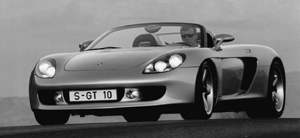 |
|
The challenge of styling the Carrera GT was to make it look fresh and exciting-and very Porsche-like-without relying heavily on the company's past styling cues and models.
|
Carrera GT Style
Harm Lagaay's part of the job was none too easy. No recent Porsche cues or design idioms were relevant. The GT1 racers had been styled to look as much as possible like a 911, not to explore new design directions. The Boxster looked backward in style, not forward, and the 911 was a successful evolution of a classic. In meeting Wiedeking's challenge, Lagaay needed to make a fresh start. He had to employ the most subtle of means. "Our brand is not identified by any distinctive element such as a radiator grille," he explained, "so its personality derives from the way we design the details and handle the surfaces. The typical Porsche shape is set by the combination of surface treatment, highlighting and tension, which to a large extent comes from the transition between convex and concave shapes." Here Lagaay and his team had the rich legacy of such dedicated artists of sheet metal as Erwin Komenda, Dick Soderberg and Wolfgang Möbius upon which to draw.
The Carrera GT was a baptismal project for a new arm of Porsche, a West Coast design studio. Porsche Engineering Services Inc. was set up in March 1999 in Los Angeles to carry out design work for Porsche and other clients as well. That spring, the studios in both California and Baden-Württemberg were assigned two days of sketching concepts that would suit a super-Porsche. Three of these were chosen to be modeled in one-quarter scale. Evaluating these at the end of May 1999, one was rejected as not having enough Porsche-ness and another as having insufficient aerodynamic potential. Coupe concepts were set aside at an early stage in favor of an open car, said Harm Lagaay: "People who buy such a car want to be seen." With the coupes, as well, it was hard to avoid results that looked 911-ish.
In the next stage, the development of a full-size model, designer Grant Larson played a key role. "We took a lot of time over it," said Harm Lagaay. "We needed surface tension to communicate some emotion." Another challenge to the designers was that the car's forms had to have high feasibility, August Achleitner told Peter Morgan: "Our stylists had a very difficult job, because they had to take account of the technical requirements. That makes this car different to a normal study. We didn't want to show a car that will be watered down for production. It is very near to a production car." That, plus interruptions, meant that the Carrera GT's body design wasn't ready until March of 2000.
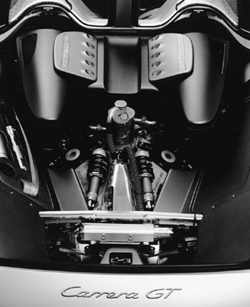 |
|
Derived from Herbert Ampferer's LMP 2000 power unit, the rear-mounted V-10 engine of the Carrera GT sat forward of the coildamper units for the racing-inspired suspension.
|
The silver-skinned clay model showed a sleek two-seater that artfully married elegance with aggressiveness. True to Porsche's principles, it expressed eager urgency without the meretricious excesses of some of its big-company rivals. Its low nose with wide inlets was unremarkable; instead the Carrera GT's character was expressed by the dashing sweep of curved lines on its flanks, from air vents behind its front wheels to engine-room inlets, and also by twin headrests fronting a carapace above its V-10 engine. A fine mesh over the engine was its "negligee," according to Lagaay, both concealing and revealing. The wing spanning its rear deck above a central tunnel in the engine cover lifted electrically to be more effective at high speeds.
The finished Carrera GTs-two concept cars were built-abounded in fascinating detail. Lifting its rear deck revealed its viscera, coil/damper units and an oil filler and cooler, with wheel-removal tools in a receptacle on the left. Cladding concealed the engine. High-intensity headlamps hid under transparent fairings while neon tubes were used for turn-signal and brake lamps. Side mirrors had vee-strut mountings. A very high yet narrow console separated the passengers and placed the sequential shift lever high and next to the wheel, like that of a rally car. The steering wheel itself was new to Porsche with a Y-shape to its central spoke, which carried several controls. This foreshadowed the style of the similar wheel of the Cayenne.
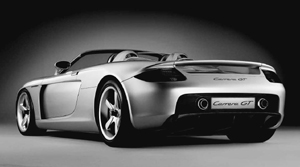 |
|
The functional side vents and beautifully integrated rear spoiler clearly stated the purpose of this powerful sports car without any of the styling excesses so characteristic of exotic supercars.
|
Instead of fixed dials, the Carrera GT used a high-definition display to communicate with its driver. He could choose either a highway-touring display or one which suited closed-circuit racing, even presenting his lap times. From a compartment between the seats a video camera swung out, at the ready to record the instrument readings or a special drive. The manually adjusted seats looked relatively flat to make entry and exit easy, but had side and knee braces that swung up into position to hold the occupants under high lateral gs. These were adjustable to suit drivers of different posterior dimensions. Front and side airbags were provided for both driver and passenger. A full windshield had attachments for the fitting of a removable roof, which could be stored in the rear compartment.
Lifting the Silence
 |
|
Behind the unusual steering wheel with a Y-shape to its center spoke lurked a high-definition display in lieu of the usual five-dial layout used by Porsche. The control for the concept car's sequential shifter was situated in the high center console.
|
The Paris Launch of the Carrera GT came as a stunning surprise. The old "leaky" Porsche company was a thing of the past. Harm Lagaay explained to Peter Morgan how this was achieved: This has been an extremely inspiring project with such a small group of people, all thinking and working in the same way in creating this super-Porsche. Young or old, it didn't matter who was working on the project, they were all saying to themselves that this was going to be the best. I think that's how we managed to keep it such a closely guarded secret. Those of us involved were 100 percent committed to the project, and even the best-informed people outside that immediate circle didn't fully appreciate what was going on.
A feature of the Paris "reveal" was stunning action footage of Walter Rohrl driving the silver GT through a dramatic desert moonscape. This was filmed during the third week of August 2000 in Nevada's Valley of Fire State Park, northeast of Las Vegas. With temperatures of 105° F and upward in the baking desert, Rohrl wished he hadn't brought black jeans to Nevada. Driving the prototype Carrera GT was no sinecure. Its triple-plate racing clutch was so fragile that a gang of pushers was always at the ready to get it going. "Around corners," however, said Rohrl, "it drives like an out-and-out racing car."
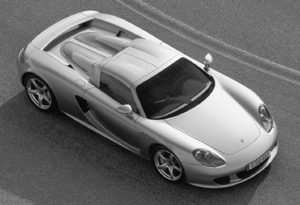 |
|
In its final design, as promised, the Carrera GT was strikingly close in appearance to its concept-car origins. The "negligee" over its engine remained and the two-piece removable hardtop was perfected. NACA inlets for cooling appeared in its rear deck.
|
Although both were envisioned as establishing Porsche at a new high level of the market, conceptually the Carrera GT was the antithesis of the 959 of almost 20 years earlier. The 959 was packed to the gunwales with electronics and hydraulics at the state of the art and beyond. It was the very quintessence of Porsche as a technological innovator and leader. The Carrera GT in contrast made no such claims. In fact it proudly forswore any but the most essential electronic aids. It was an avowed emotional interpretation of a sports-racing car for the road, much more a Dauer GT than a 959. And unlike the four-wheel-drive supercar, if built it would be homologated for sale in the good old US of A.
One thing the Carrera GT would not be was a spectacular money-loser for the company in the tradition of the 959. "You may rest assured that it is not our corporate policy to subsidize this product segment," said Wendelin Wiedeking at the GT's Paris launch. "Rather, each and every car we introduce must contribute to our overall business results. So we will test the acceptance of the car in the market and the size of the market before taking the final decision to build the Carrera GT." Assessing the market's size was the tricky part, he admitted: "Nobody really knows for sure how big the market segment is for the Carrera GT and its possible competitors," embracing two-seater sportsmobiles costing between $300,000 and $500,000. A certain jostling for position seemed likely.
Were the Carrera GT to be built, it would make nonsense of a statement by sales chief Hans Riedel in the context of the Cayenne decision. "We don't live by replacement," he said, "but we live by discretionary income. So we want to enter larger and less volatile segments." This fitted the Cayenne decision to a T, but it would be hard to find a smaller and more volatile segment than the one the Carrera GT would occupy. Yet Riedel had another saying that was applicable. It was: "With 12 the first kiss, with 22 the first job and with 42 the first Porsche." To that he could add, "With 52 the first Carrera GT." From technology the Porsche brand's appeal had been successfully refocused toward emotion during the 1990s, and here was one hell of an emotional Porsche.
 |
|
|
Canvassing his dealers and distributors about demand, working with pricing in the range of $350-400,000, Hans Riedel had little difficulty in drumming up interest in this spectacular car. By the end of 2001 more than 1,000 provisional bookings had been logged with Ludwigsburg. At that time the rumor mill ground out reports that the go-ahead to produce the Carrera GT had already been given, with spy shots showing an early double-bubble roof design. Wendelin Wiedeking confirmed this in Detroit in January 2002. He mentioned a 1,000-car run phased over several years at a rate of two or three cars daily.
Production Proceeds
Development of the Carrera GT for production was assigned to Weissach's motorsports group, backed up by other resources at the engineering center. Herbert Ampferer was in charge of the project, which benefited greatly in its later stages from the involvement of veterans Norbert Singer and Roland Kussmaul.
They faced no shortage of challenges. The V-10 was converted from its noisy gear-train camshaft drive to quieter chains providing a VarioCam system for the inlet valves. Instead of the sequential-shift racing transmission, said August Achleitner, a gate-type manual shift for the transverse six-speed gearbox was used "because the Americans prefer it." Only 6.7 inches in diameter, a twin-disc ceramic-faced clutch coped with 435 lb-ft of torque at 5,750 rpm from the 5,733 cc (98 x 76 mm) ten, which produced 605 bhp at 8,000 rpm in production form. Replacing the provisional aluminum structure of the prototypes was a monocoque of carbon-fiber-reinforced resin. True to the commitment made when the Carrera GT was designed, its styling was little changed.
In overall charge of the Carrera GT's engineering was Porsche's new board member for R&D, Wolfgang Dürheimer. Taking over from Horst Marchart in the spring of 2001, the 43-year-old Dürheimer gained a sense of the size of the shoes into which he was stepping from the tribute paid the departing Marchart by Wendelin Wiedeking. "With his great store of experience, both technical and human, but also with the proverbial calm of the Austrian," said the Porsche chief, "at critical moments above all he influenced many important decisions in a positive way. For me Horst Marchart is a foundation stone of Porsche from whom we all-whether at Weissach or in the board-have much to learn." Marchart had been expected to remain in his post longer but, as he told a colleague, "Too many people are dying young. I'll retire sooner than I thought."
Bespectacled and curly-haired, Wolfgang Dürheimer was the first technical chief to parachute into his post without substantial experience at Zuffenhausen or Weissach.4 This was not necessarily a negative, said one senior engineer, "but it would have been better to have someone from within." Dürheimer was a BMW man, said the engineer, who remarked that there were "lots of BMW people coming in" to Porsche's technical side to join those who'd already infiltrated the sales and marketing ranks.
Wolfgang Dürheimer was born in Germany's most southerly region, Bavaria's Allg,u Alps, in 1958. After his engineering tuition in Munich he studied in America for a year under a Fulbright Scholarship. Completing his economic and engineering education in Munich, he joined BMW as a trainee in 1984. His curriculum vitae there included two years as product manager for coupes and special engines. From 1994 Dürheimer headed R&D and product management for BMW's motorcycle arm where, as he said, "I was trying to get them interested in racing, but getting no response."
Thus Dürheimer was susceptible when, in 1998, "someone contacted me and said, `Are you interested in sports cars?' So I said, `Why not?' I already knew something about Weissach from the joint work we'd done on motorcycle projects, so I appreciated the strength of the individual departments." Wolfgang Dürheimer joined Porsche in January 1999 with the assignment of working on the Type 996. Only after his arrival did the bombshell of Marchart's retirement explode, propelling the youthful yet experienced engineer into his board position.
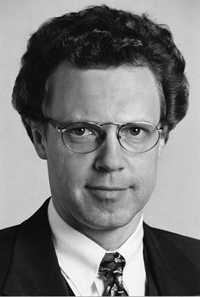 |
|
After joining Porsche in early 1999, Wolfgang Dürheimer was elevated to the post of board member for Research and Development in spring 2001 to take over from the retiring Horst Marchart.
|
Supervisory-board chairman Helmut Sihler welcomed this new-generation technical chief. "Young, talented yet very experienced people must and will constitute the future of our company," said Sihler. "In recent years Wolfgang Dürheimer not only has shown what he can do but also has grasped the product and company philosophy of Porsche in a visible and vital manner." Commenting about his new job, Dürheimer said: "We know what we have to do. We are pure, and we remain pure. We don't need any bric-a-brac. The attractiveness of our cars lies in their purity. We know that Porsche drivers appreciate that, and they'll also be able to do that in the future." Evolution rather than revolution was his declared objective: "The new must be new, without making the old look old."
Like Bez before him, Dürheimer brought some of BMW's engineering management methods to Porsche. Paying a compliment to the knowledge and competence he found at Weissach, he "strengthened the cooperation, secured the lateral connections between departments and optimized the information flow." The new top engineer considered it a "prerequisite to develop and implement a completely new organization model. I've introduced a new upper-level department whose mission is described by its name: `Concepts, Innovation and Computer-Driven Technologies.'" For the Carrera GT, he added, "we're working flat out on this development, which represents racing technology for the road."
Porsche's Motorsports Future
With his motorsports people developing the GT, said Dürheimer, "we can very well do without participation in major motorsports until we've completed this project." Here he touched on a topic of intense interest to all Porsche enthusiasts. After the disappointment engendered by its parking of the LMP 2000, the company had had little to say about a possible return to the front lines of the sport that had made its reputation. The only news was no news. Committed as he was to bringing the Carrera GT to market at the end of 2003, said Herbert Ampferer, he had no time to prepare for 2004. Thus 2005 was the earliest that any top-level initiative could be launched by Porsche.
In spite of its stumbles a decade earlier, Porsche was still a target for teams desiring Formula 1 engines. In 2000 it was approached by the Swiss Sauber team, which then was leasing engines from Ferrari. Its major sponsor, Malaysia's oil firm Petronas, was prepared to back the creation by Porsche of an engine that would carry its brand name, much like the TAG V-6 of the 1980s. The sum of $50 million a year was mentioned during the planning for an engine that would first take to the tracks in 2003. Porsche declined, however, and supervisory-board member Ferdinand Pi%ch explained why:
We have established guidelines for the running of the smallest independent automobile company in the world so that it doesn't again slide into a threatening crisis like the end of the 1980s. That means that if a Formula 1 project can be carried out for an outside customer and does not thereby overload the company, then we regard such an engagement in a positive way. But the project under discussion did not fulfil this requirement. And also against the background of the current economic situation the Porsche management and supervisory boards have decided in the negative.
Porsche hinted at a Formula-1 future when Chancellor Schröder opened its Leipzig factory. Its adjoining race track, an official pointed out, had corners modeled after those of several noted tracks and would be developed to an FIA-approved circuit capable of hosting a Formula 1 race. Its towering customer center overlooked a starting grid on which the cars' positions were already marked. Here was a company that clearly wished to keep all its options open, even those that were most ambitious.
Friends of Porsche could take heart from a comment by Wendelin Wiedeking as long ago as 1993. "Without motorsports Porsche would not be that which it is today," he said. "And here we have to regain the status that we once had." Only one small detail stood in the way, he added: "For that we'll need more cash in hand." In 2002, when he had the cash, Wiedeking elaborated on this theme. "Porsche without racing would not be Porsche," he restated succinctly. "My engineers would rather be back in racing today than tomorrow. Once the Cayenne has its market launch we'll again have capacity available to address this. But if we're to reenter motorsports, it must help to position the brand clearly in the future and expand our turnover. If these prerequisites aren't met, advertising is the more plausible alternative."
Some feared, however, that engineering capacity and funding would not be the only desiderata for a racing return. Even if Porsche could afford to develop new cars for racing-which it could from 2003 onward-did it still have the skills? "I think it is too early to draw a conclusion about the capabilities that we have at Weissach today," racing veteran Norbert Singer replied to a question on these lines. "Everybody knows we are thinking about racing for the future and we are thinking about all kinds of possibilities. Put it this way: I am still here and there should be a transition-I hope!"
In the meantime Porsche engaged popular racer and rallyist Walter Rohrl as an ambassador to its press and public, giving a strong whiff of race-track aromas to its external initiatives as in his filmed drive in the Carrera GT. This was a role well tailored to the tall and genial German. In March 2001 Wiedeking made a similar offer to Frenchman Bob Wollek, whose incredible record included 30 Le Mans appearances, two-thirds of them in Porsches, and a record seven Porsche Cups. Still racing at the age of 57, Wollek was delighted by this recognition and looking forward to taking up his new role when he was hit by a car and killed while bicycling before the Sebring 12 Hours. His funeral was held in the same Alsatian church in which he had been christened simply "Bob," not "Robert." Wollek's was a moving loss to the Porsche family
Customers Into the Breach
When Porsche didn't race, its allies often stepped into the arena on its behalf. One such was Florida-based Dave Maraj, whose Champion Porsche dealership fielded the hottest equipment the factory could supply. Maraj gained Herbert Ampferer's acquiescence to his installation of a twin-turbo 3.2-liter GT1 engine in an open Lola B2K/10 sports-racer to campaign in the Americans Le Mans Series. Like other turbo-powered cars, however, the Champion Lola-Porsche did not fare well under ALMS engine-equivalence rules. Although not allowed to assist the Champion effort, Ampferer was permitted to learn from it. The Lola-Porsche was shipped to Weissach, where it was evaluated both in the tunnel and on the track-by Bob Wollek- and in comparison to Porsche's similarly powered LMP1 98.
Another American sanctioning body, the Grand American Road Racing Association or GARRA, opened its doors to Porsche power with a new formula for sports-racing cars that took effect in 2003. Wheelbases were to be in the range of 108 to 110 inches with overall lengths from 175 to 180 inches. Wheels were 18-inch with maximum widths of 12 1/2 inches in front and 13 in the rear. Engines weren't stressed; the chassis had to roll with its engine removed. Frames had to be aluminum honeycomb or tube or a combination of these. Minimum weights without driver and fuel were on a sliding scale against engine sizes, as follows:
Up to 3.65 liters 1,975 pounds 896 kg
3.66 to 4.35 liters 2,000 pounds 907 kg
4.36 to 5.0 liters 2,025 pounds 918 kg
5.01 to 5.5 liters 2,050 pounds 930 kg
These and other detailed provisions, together with the approved engines and builders, were in the seven-page Daytona Prototype regulations promulgated by GARRA. Included was the ingenious requirement that both head and tail lamps use the exterior lenses associated with cars made by the engine supplier, which also must contribute exterior rear-view mirrors. A rear window was mandated, not for vision but so that the engine could be seen.
 |
|
Long time Porsche racing proponent Brumos Porsche commissioned Indianapolis-based Fabcar to build Daytona Prototypes powered by 475bhp GT3R engines acquired from Alwin Springer, Porsche's racing chief in the United States.
|
Dave Klym, whose Indianapolis-based Fabcar had a role in developing the rules, was the first to be commissioned to build Daytona Prototypes. His customer for two cars was Bob Snodgrass of Florida's Brumos Porsche, long-time entrant of Porsches in competition. Fabcar was a Porsche veteran in America, during the 1980s acting as the principal source for Porsche 962 tubs and components for IMSA racing. From Alwin Springer of Porsche in North America, Brumos sourced two GT3R 3.6-liter engines of 475 bhp for its Fabcar coupes, which looked surprisingly Porsche-like with their front and rear lamp lenses.
Fabcar's FDSC/03 had a tubular space-frame structure of mild steel that incorporated a mandatory roll cage and carbon-fiber crash-impact side pods. Unequal-length wishbones suspended the front while at the rear the upper wishbone was supplemented by an adjustable toe-control rod behind the wheel centerline. While the conventional rear anti-roll bar was only crew-adjustable, at the front Dave Klym used his trademark double-ended pivoted blade as a cockpit-adjustable anti-roll restraint, driven by rods from the inboard suspension parts. As required by GARRA rules, coil springs and dampers were mounted concentrically. Brakes were by Brembo and the rack-and-pinion steering was power-assisted. To ease the interface with the Porsche engine, Fabcar fitted the GT3R wiring harness to its FDSC/03.
Endurance testing of the Porsche-Fabcar6 at Daytona began with a six-hour trial on Thursday, December 5, 2002. A 28-hour session started at 10 a.m. Friday and wrapped up at 2 p.m. Saturday. This was declared a complete success for the Porsche-powered racer, which needed only a minor oil-leak repair during the night. Among eight drivers trying the Brumos car were five-time Daytona 24 winner Hurley Haywood as well as Scott Sharp, David Donohue, Scott Goodyear, J.C. France, Mike Borkowski, Wayne Jackson and Chris Bye.
"You always hope that you have a test like this," said Fabcar's Dave Klym. "We liked to believe that testing would go this well. There wasn't anything on the car that we felt uncomfortable with." "I think the test was a huge success," said Brumos's Mike Borkowski, "for a brand-new car with totally new rules and regulations. We've now gotten closer to the sweet spot on the car, so it's now getting fun to drive. I think this formula is going to be the first one in a long, long time that's really going to be the right thing. The cars are plenty fast. They're really cool looking."
Starting in 2003, the Porsche-Fabcars competed against cars powered by BMW, Ford and Toyota engines in GARRA's Rolex series of races, ranging in length from 250 miles to 24 hours. Hurley Haywood, with an unmatched record of Porsche-powered success, was one of the new coupe's drivers at its Daytona debut in February 2003. In America, at least, Porsche engines were back on the tracks.
Looking Ahead and Behind
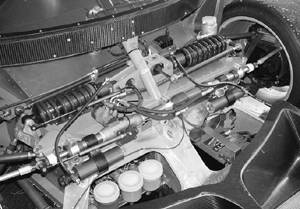 |
|
With its front body panel raised, the steering gear, concentrically-mounted coil-over damper assemblies and master cylinders of the Fabcar FDSC/03 were revealed.
|
While Weissach's motorsports group looked toward 2005, other engineers on the site were exploiting Porsche's enhanced R&D capabilities on behalf of its own cars and the projects of its many outside customers. Horst Marchart had commented, "We have become more scientific in the way we work. Maybe this is not always as exciting as it used to be, but the final result is really impressive." The educated instincts of experienced engineers were giving way to the focused exploitation of the most advanced computer-simulation techniques to gain better results in less time at lower cost.
Into the twenty-first century, Ernst Friedrich Hahn was in charge of Porsche's engineering work for outside clients. To attract them he could point to an exhaustive array of testing and evaluation facilities for all aspects of motor vehicles and other products7 manned by 1,000 of the 2,250 staff at Weissach. It was always adding to these capabilities; in 2001 it opened a new test track expressly designed to evaluate drive-by noise. This was part of a focused effort by Porsche's staff to develop a dedicated capability in this important area. When big projects such as the Cayenne were not absorbing capacity, said Hahn, he could call on up to 30 percent of Weissach's engineering time to serve his customers.
Hahn also inherited a profitable portfolio of patented engineering innovations that picked up where the famous Porsche ring synchromesh left off. Among them were Tiptronic control of conventional automatic transmissions-adopted by many makers-and CVTip, a means of making a continuously variable transmission act as if it had stepped ratios to give a more defined driving experience. Other in-house developments such as the VarioCam Plus method of controlling valve timing were eminently suitable for money-spinning licensing.
Another earner for Porsche was its intensified interest in providing spare parts and technical information for its older models. This first became a topic of interest in the 1970s when Ohioan Chuck Stoddard, an MIT-trained engineer and Porsche dealer, began making and marketing hard-to-find parts for the early cars. Looking forward rather than backward, the factory had not bothered overmuch about parts for the Type 356, for example. But in 1977 Porsche's parts manager, Herbert Burkhardt, decided that it was time for the factory to take an interest and contacted Stoddard.
Long and difficult discussions led to plans for a joint venture. Porsche and Stoddard would be joint owners of a new company dedicated to the orderly making and delivering of parts for old Porsches. As part of the preliminary arrangements Porsche acquired Stoddard's Cleveland, Ohio dealership. Logical though it was, with its center of gravity in the important American market, this plan ran aground on rocks on Porsche's shores and was never implemented-to Stoddard's understandable disappointment.
In 1991 Herbert Burkhard was again a key player when Porsche Classic GmbH opened its doors for business on the first of January. Encouraged in the 1980s by Peter Schutz to pursue this opportunity, Burkhard was the first managing director of the new firm set up expressly to serve the classic-Porsche market. "We shall extend our activities every year to cover all the cars that are out of production," he said at the time. "Once a model is about 10 to 15 years old the responsibility for parts will be transferred from Porsche AG to Porsche Classic."
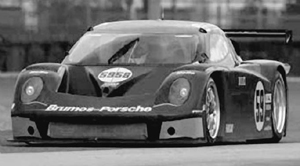 |
|
When first tested at Daytona in early December 2002, drivers included Hurley Haywood, Scott Sharp, David Donohue, Scott Goodyear, J.C. France, Mike Borkowski, Wayne Jackson and Chris Bye. Constructor Dave Klym considered the test a resounding success with virtually no problems reported.
|
Burkhard's new company launched with spares and technical information for the 356, the 914 and the 911/912 through the 1973 model year. A decade later Porsche Classic's new chief, Klaus Boizo, announced plans to extend his parts range to include the 924 and 959, plus the 928 and 911 through their 1983 models. Classic's parts carried a two-year warranty.
Key parts customers were the members of Porsche clubs throughout the world. In 2002 the first such club, Porsche Club Westfalen e.V., celebrated its fiftieth anniversary with four days of festivities that included visits to Zuffenhausen and Weissach. Their tour of Zuffenhausen took in the Porsche Museum, which had been headed by former racing aide Klaus Bischof since 1993. Only the tip of his 300-car iceberg was on display in the small showroom adjoining the factory. Bischof usually had some 80 cars on the move around the world to show the flag at events, parades, tours and classic-car races.
Working originally with Huschke von Hanstein, Ilse Nädele took the lead in bringing the world's Porsche clubs under a common umbrella. After her retirement from Porsche, Nädele focused her leadership skills on the Porsche clubs in Germany. Her tradition was continued by a small team under Jutta Aldenhoff, which published a comprehensive monthly bulletin to and about the clubs.
A survey at the start of the third millennium showed that throughout the world Porsche enthusiasts were supporting 440 clubs, including umbrella organizations and those catering to vintage models. Of the 570,000 Porsches registered in major markets, an astonishing 18.3 percent were owned by club members. The ratio in America was 21.8 percent and in Europe 14.7 percent.8 Pre-1988 model year 911s were the most popular among club members with 23.8 percent of the total, while the 356 accounted for 13.1 percent-a doughty survivor indeed-the 944 for 10.8 percent and the Type 964 911 for 9.4 percent.
Present and future Porsche fanatics from all walks of life were catered to by the company's Porsche Driving Experience program. This had two main aspects. Owners interested in improving their driving skills could enroll in classes at great race tracks in many countries in a program managed by the Ludwigsburg marketing department. Those who wanted to enjoy Porsche driving on great roads could do so on tours-often with Porsches included-organized by travel agents ConTeam Human Event GmbH in cooperation with Ludwigsburg. This included tours from weekend breaks in the Black Forest or along the Bodensee to a blast along Route 66 or a desert safari based in Dubai. The Cayenne opened up many new opportunities for this Wiedeking-era initiative, calculated as it was to intensify emotional involvement with Porsche's products while more than covering its costs.
From Strength to Strength
No one would be surprised to find Porsche Adventure Holidays opened up to cyclists. Under the entrepreneurial Wiedeking, in 1996 Porsche began offering premium-category mountain bikes to its dealers and selected bicycle shops. Votec was its subcontractor for the exotic bikes, which were available in "S" models with front suspension and "FS" with suspension for both wheels. From their aluminum frames and handlebars to their Italian saddles, hydraulic brakes and Sachs drive trains the Porsche bikes bristled with features craved by the connoisseur.
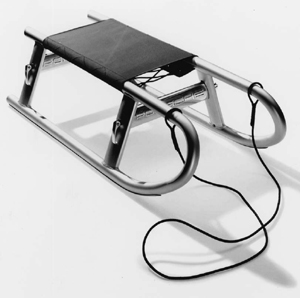 |
|
Constructed of tubular aluminum with steel runner surfaces and a stretched and laced nylon top, the Porsche sled could be folded and carried in a convenient nylon case.
|
The "FS Evo" version with Kevlar-backed saddle and carbon-fiber three-spoke wheels was priced at $6,000 in 1998.
Lest winter sports enthusiasts should feel left out, for the 2001 snow season Porsche introduced its own branded sled. No run-of-the-mill Rosebud this. Fashioned of aluminum tubing with steel runner facings, it had demountable lateral braces to allow it to fold into its Nylon carrying case. Weighing only 11 pounds, the Porsche Sled was the ultimate winter accessory. In addition to these non-car products, said Wendelin Wiedeking, "we do accessories such as watches and sunglasses which boast a turnover of DM100 million." Added to that, he said, "we have a large leasing business in Germany, the US, Italy, Britain and Japan that is making money."
Making money was proving to be as much a Porsche knack at the turn of the millennium as its ability to produce appealing cars. Profit in its 1998-99 fiscal year was a satisfying $368 million, more than double the previous year's earnings, on sales that were up by 26 percent. Next year was better still and in 2000-01 gross profitability was $529 million. This in turn was put in the shade by the 2001-02 results, which counted up $817 million in pre-tax profits and net earnings of $455 million-an increase of 71 percent-on sales of $4.7 billion, up 9.4 percent. Financial analysts hailed this as "brilliant" and "amazing," especially against the background of the added costs attendant upon bringing the Cayenne to market, and dubbed little Porsche "the world's most profitable carmaker."
Where profits went so too did the publicly held shares of Porsche. From the depths they reached in the crisis-hit year of 1992, Porsche's non-voting shares increased twenty-fold in value to reach 3,100 euros (about the same in dollar terms) by the beginning of 2000. At Porsche's annual meeting that February, shareholders lobbied for a split in the stock-then the most expensive on the market-to make it more accessible. Resistance to this came from the Porsche and Pi%ch families, which jointly held shares valued at some $6.5 billion. If the shares rose further in value, they feared, their next generation would be hit by heavy inheritance taxes.
By the end of 2000 Wiedeking won the families over, and a ten-for-one stock split took place in 2001. It did indeed rise further in value, reaching a high of 560 euros in 2002 and ending the year in the mid-400s. In the three years from the beginning of 2000 to the end of 2002 Porsche shares rose by 70 percent, a period when the German stock-market index fell by one-half. Small wonder that when Germany's private shareholders were polled by manager magazin in 2002 and asked which of their country's managers they would trust to create a lasting increase in share value, Wendelin Wiedeking topped the list. He ended a six-year run of success by BMW chiefs.
The stock performed well in spite of controversy in 2001 over Porsche's financial reporting. Porsche's shares were quoted on Frankfurt's M-Dax, a group of 70 mid-sized companies. However, the Frankfurters disliked Porsche's omission of quarterly financial reports and demanded that these be provided as a condition of remaining in the M-Dax. Their ultimatum was ironic in that Porsche received two awards in 2001 for its excellent investor-information policies. These, said the firm's investor-relations manager Manfred Ayasse, were the consequence of "credibility. Porsche has been successful in the stock market because it has always been credible."
Wendelin Wiedeking stoutly resisted the idea of quarterly reporting. "Our business is highly seasonal," he pointed out. "We sell more cars in the summer than in winter. In August we have a works vacation. Naturally our people continue to be paid. The costs continue but not a single car is produced, so our results would be anything other than in the black. This can't be a sensible basis of information for our shareholders. The danger, in fact, is that we then try to run the business to make the quarterly numbers look good." Quarterly reporting catered to speculators seeking a quick return, but "we don't want short-term investors," said Porsche's Anton Hunger. "We have to protect our investors; we want investors who take a long-term view."
Rather than bow to the M-Dax's demands, Porsche upped stakes. It withdrew from the M-Dax and instead joined the international MSCI Index, which weighed such company attributes as liquidity, strategy and market capitalization. On leaving M-Dax Porsche slammed the door. When it placed $300 million in bonds to help fund its activities in 2002 it ignored the big Frankfurt-based banks and issued them instead through home-town institutions in Stuttgart. "The Frankfurters earned nothing," said Wiedeking with some satisfaction. "You see, we don't forget."
Also in 2002, Wiedeking and his finance director Holger Härter nurtured plans to make a secondary offering of Porsche shares on the New York Stock Exchange. This would make them more accessible to a market in which institutions already had heavy Porsche holdings. But after the shocking collapse of energy-broking firm Enron, the US government passed the Sarbanes-Oxley Act requiring top company executives to certify their financial reports personally. "I take oaths seriously," said Wiedeking about the Act's requirements. "You can never be sure that results which thousands of people have had a hand in preparing are completely correct." In October 2002 Holger Härter announced that Porsche would not seek a New York listing after all, citing "considerable extra costs" and calling the Act's demands "illogical" and "irreconcilable with German law."
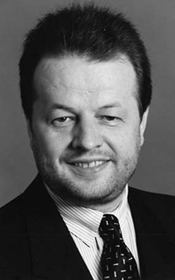 |
|
By 2002, Holgar Härter was Porsche's finance director. Among other projects, Härter worked with Wiedeking to plan $300 million in bond sales through Stuttgart banks.
|
Porsche's feisty independence was also manifested in Brussels, where the European Union adopted a new regulation in 2002 that blocked car makers from insisting that their dealers handle their brands exclusively. Porsche argued that it should be exempted from the new rule's provisions on the grounds of its small size and minimal impact on the European car market. Shorn of exclusivity, it maintained, its dealers wouldn't be able to afford needed investments in their showrooms and service shops. Porsche was able to point out that from 2000 it met the EU's objectives by setting identical pre-tax euro prices for its cars in Germany, France, Spain, Italy and Portugal, the countries where it owned its own distributors, thus showing that it was trading fairly in Europe's major markets. The EU Commission duly issued Porsche with a "comfort letter" stating that it would not have to comply with the new rules.
World-wide investment by dealers at the beginning of the 2000s was hefty at $762 million to adjust their systems to the added parts and volume of the Cayenne, with improved showrooms and more distinctive Porsche-look identity. In America, where the Cayenne was forecast to increase Porsche's volume by 50 percent, PCNA expected its 192 dealers (and 11 in Canada) to spend a total of $300 million to upgrade their facilities. Outlets selling more than 300 cars a year were asked to build dedicated dealerships to specifications that included a curved facing of brushed steel and a dark showroom floor with a matte finish. Smaller dealers were pressed at least to have a separate salesroom dedicated to Porsches. In 2002, 44 dealers were well on their way to establishing stand-alone dealerships.
A certain frisson in PCNA's relationship with the factory arose in 2002 when the American importer decided to boost flagging Boxster sales by making a special offer to the 52,000 members of the Porsche Club of America. Rebates of $500 and $1,000 respectively were offered for the purchase of a new Boxster or Boxster S. A spokesman for PCNA called this "part of a much larger endeavor to work more closely in partnership with the Porsche Club," aided by PCNA's hiring of a full-time person to liaise with the PCA. "They may not buy cars every year," said a dealer about the PCA members, "but they are the experts that somebody else talks to. They refer customers to us."
This scheme had only one snag: PCNA hadn't told the factory about it. When Wendelin Wiedeking heard about the Boxster rebates he was hopping mad. One thing that Porsche didn't do was undermine the precious value of its brand by openly discounting its products. PCNA's Fred Schwab was defensive: "It doesn't count as an incentive because it's only for the Porsche Club." The offer wasn't withdrawn; it stayed in place to the end of 2002. But, said Wiedeking, "it won't happen again. We will reduce production before starting discounts."
By the twenty-first century the Porsche car company had disassociated itself in Western Europe from the Salzburg-based Porsche Holding GmbH, the sister company that Louise Pi%ch, Ferry's sister, had led so successfully. The two firms continued to be allied in Eastern Europe, however, where the Holding's wholesale division, headed by Wolf-Dieter Hellmaier, sold Porsche cars in Romania, Slovenia, Hungary and Slovakia. The East was the focus of expansion for privately held Porsche Holding, which was doing very well. Its 2001-02 turnover was $5.5 billion and its employment 10,970-both higher than the family's car company.
With Stuttgart delivering far higher profits than Salzburg, the last thing Wendelin Wiedeking was worried about was a deficit in sheer size. "If size were the only criterion," he liked to say, "the dinosaurs would still be with us." Often asked whether Porsche was too small to survive as an independent car company, he robustly defended its decision to go it alone. "Our thinking on this at Porsche is clear," he said: "The future won't belong exclusively to the large. The small and the skilled will be able to claim no less success-perhaps, indeed, even more. A company with our size is always much more flexible in the market than a bigger one. If something happens you can react. The big players need too much time."
Confidence in the Future
Staying small didn't mean standing still, Wiedeking believed; quite the contrary. "When our third leg is firmly on the ground," he said before the Cayenne was launched, "then-and that's entirely logical-more things must follow if Porsche is not to belong to the marketing department of one of the big companies one day. It's very simple: after three comes four. And believe me, we have enough fantasy and financial means to bring more and more attractive models to market over the next ten years."
There was every chance that Wiedeking would see them to market. At the end of 2001 the supervisory board extended his contract to 2007, when he would still be only 55. Rumors of his possible defection to Volkswagen's top job had been brushed off by the "Double W," as they called him at Porsche. "I can't see any reason for me not to be happy at Porsche," he said. "I've received a lot of good offers, possibilities, but I always reject them because I feel very good here in the Porsche organization. I have plenty to do, they pay me well, and I drive the best cars in the world."
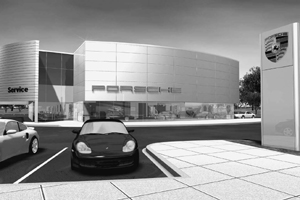 |
|
As North American dealers committed to $300 million to upgrade their facilities, Porsche devised specifications for a family look for their new showrooms that included a curved facing of brushed steel and a dark sales room floor.
|
Having plenty to do was a Wiedeking watchword. He liked to keep his people busy. "After introducing the Boxster and the 911," he explained, "I think the organization thought, `Now we're where we want to be.' I said, `Unh-unh. That was yesterday. Now for the next steps. I started to talk about visions for 2005 and 2010. Where will the company be then? What will we do? This is my job, because a company must grow. If a company is not able to grow, it is not able to survive. If you stagnate, that's the beginning of the end.
"This company has huge potential for the future," Wiedeking added. "Porsche is following a growth strategy." The Cayenne was just the first stage in that growth. At the beginning of 2001, said Wiedeking, "we presented our supervisory board with products for ten years. Not ideas; products." Some, including Wiedeking, envisioned Porsche selling 100,000 vehicles a year not far in the future. "That's where Porsche will be soon," he said in 2002, adding, "I think the next big step for us is to beat $10 billion in revenue."
The Porsche chief had a shrewd sense of what made his offerings so appealing. Cheapness wasn't among them: "I think there is a relationship between exclusivity and price. You can't call a cheap model an exclusive model. That doesn't work." A sense of exclusivity was essential, Wiedeking said. "We want to have only exclusive products. That means that even with other models we'll want to follow a niche strategy." Decisions on other models or derivatives, he said, would have to wait until mid-2003 when the Cayenne was well established in all its world markets.
"Every day I have to inspire enough customers to buy our products," the Porsche chief continued. That seemed obvious enough, but he realized that there was another dimension to the Porsche proposition: "I also have to take care that none of our customers is obliged to defend his buying decision in his social milieu. That's an important facet of our corporate philosophy."
This was a subtle yet vital advantage of the Porsche offer, imbued as it was with an aura of the ultimate in active and passive safety, low emissions, reliability and long life. Because these attributes were emphasized so successfullyin the company's advertising, the Porsche buyer could be confident that the choice he made emotionally-for no one must buy a Porsche-would be respected by his neighbors and colleagues rationally. No other car maker could make that statement. This singular combination of qualities secured Porsche its unique place in the twenty-first century's automotive world.
|